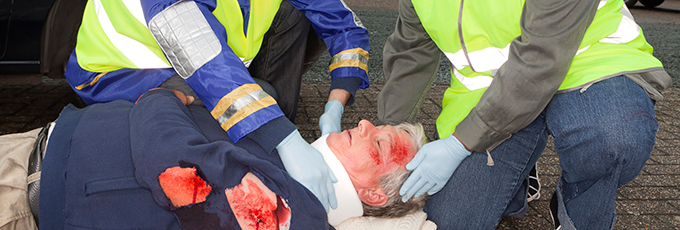The research studies listed below are currently open for enrollment for adult subjects. They may involve one or more of the following: practicing movements, neuroimaging, EEG, or neuropsychological testing. Please see the link below for the procedures and eligibility criteria for specific studies. There is no cost for participation or for any tests associated with the research.
Is there any treatment?
Anyone with signs of moderate or severe TBI should receive medical attention as soon as possible. Because little can be done to reverse the initial brain damage caused by trauma, medical personnel try to stabilize an individual with TBI and focus on preventing further injury. Primary concerns include insuring proper oxygen supply to the brain and the rest of the body, maintaining adequate blood flow, and controlling blood pressure. Imaging tests help in determining the diagnosis and prognosis of a TBI patient. Patients with mild to moderate injuries may receive skull and neck X-rays to check for bone fractures or spinal instability. For moderate to severe cases, the imaging test is a computed tomography(CT) scan. Moderately to severely injured patients receive rehabilitation that involves individually tailored treatment programs in the areas of physical therapy, occupational therapy, speech/language therapy, physiatry (physical medicine), psychology/psychiatry, and social support.
The Effect of Exercise on Mood After Traumatic Brain Injury
This study has been completed.
First Received: December 10, 2007 Last Updated: June 2, 2008
Sponsor
University of Washington
Information provided by:
ClinicalTrials.gov
Identifier: NCT00571545
Purpose
We proposed to examine the effect of an aerobic exercise intervention on depression in persons with Traumatic Brain Injury (TBI). We will compare persons with chronic brain injury who are assigned to receive the exercise intervention with those in the control group to determine the effect of exercise on levels of depression and specific symptoms related to depression including anxiety, pain, sleep, and cognition. In addition, the effect of exercise on activity, participation level, and quality of life will be examined.
HYPOTHESES
- Participation in an aerobic exercise intervention will decrease the severity of depression in persons with chronic TBI.
- Participation in an aerobic exercise intervention will lead to improvements in negative symptoms associated with depression including anxiety, insomnia, pain, and impaired cognitive functioning.
- Participation in an aerobic exercise intervention will be related to improvements in activity and participation for patients with TBI.
- Participation in an aerobic exercise intervention will lead to improvements in perceptions of quality of life.
-
References
- Centers for Disease Control and Prevention. Sports-related recurrent brain injuries: United States. Morb Mortal Wkly Rep. 1997;46(10):224–227.
- Thurman DJ, Branche CM, Sniezek JE. The epidemiology of sports-related traumatic brain injuries in the United States: recent developments. J Head Trauma Rehabil. 1998;13(2):1–8.[PubMed]
- Sosin, D.M., Sniezek, J.E., & Thurman, D.J. (1996) Incidence of Mild and Moderate Brain Injury in the United States, 1991. Brain Injury, 10(1): 47-54.
- Kraus, J. F, and MacArthur, D. L. (1996) Epidemiologic Aspects of Brain Injury. Neurologic Clinics, 14(2): 435-450.



No Comments